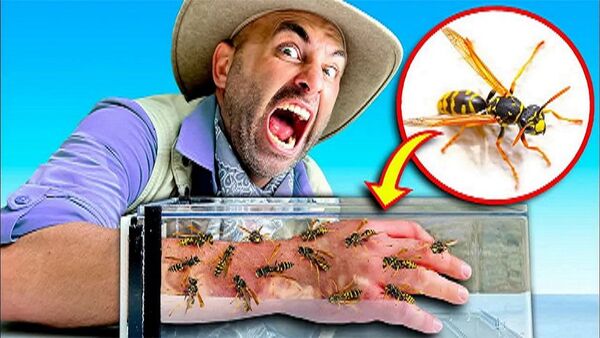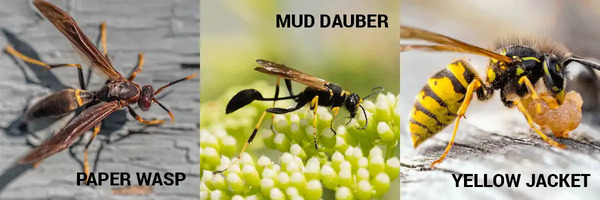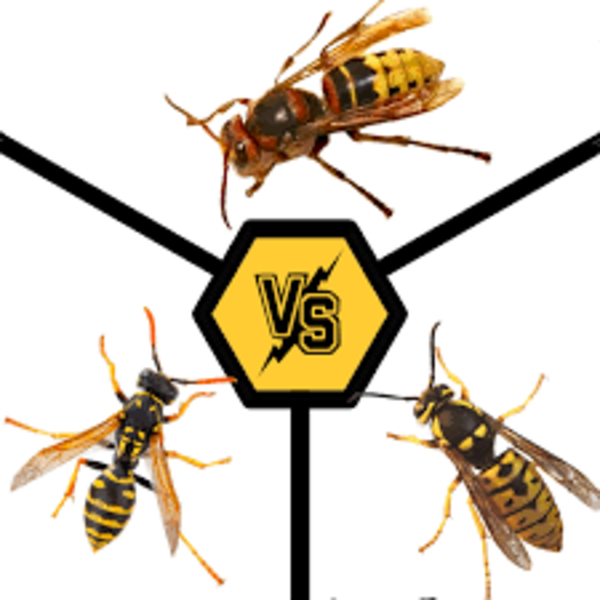When you're spending time outdoors, you might encounter a variety of stinging insects. Among the most common are hornets, yellow jackets, and wasps. While they might seem similar at first glance, there are some important differences between them. In this article, we'll break down the distinctions between hornets, yellow jackets, and wasps in simple terms, so you can understand what sets them apart and how to stay safe when you're around them.

Hornets are a type of large, aggressive wasp. They belong to the Vespa genus, and the most well-known species is the European hornet (Vespa crabro). Hornets are usually bigger than regular wasps, with some species reaching up to 2 inches in length. They are typically brown or black with yellow markings, though some species can have a more reddish tint.
Size: Hornets are generally larger than other wasps, measuring up to 2 inches.
Appearance: They have a more robust, rounded body with brown and yellow stripes.
Aggression: Hornets are more aggressive than yellow jackets and other wasps. They defend their nests aggressively, and their stings can be quite painful.
Nesting: Hornets build large, paper-like nests in trees, under eaves, or in other sheltered locations. Their nests can be quite impressive, sometimes as large as a soccer ball.
The sting of a hornet is more painful than that of a regular wasp. Hornets can sting multiple times (unlike honeybees, which can only sting once), and they can be more dangerous, especially to people who are allergic to stings.
Yellow jackets are another type of wasp, but they differ from hornets in size and behavior. They are typically smaller than hornets, around 0.5 to 1 inch in length. Yellow jackets are known for their bright yellow and black markings, which make them easily recognizable.
Size: Smaller than hornets, usually ranging from 0.5 to 1 inch in length.
Appearance: Yellow jackets have a distinctive black-and-yellow striped body. Their wings are often clear with a slight tinge of brown.
Aggression: Yellow jackets can be very aggressive, especially when they feel their nest is threatened. They will often sting without much provocation and can swarm in large numbers.
Nesting: Yellow jackets typically build their nests in the ground, in abandoned rodent burrows, or in wall cavities. They can also nest in sheltered areas like attics or under porches.
Yellow jacket stings are painful and can cause swelling, redness, and itching. Like hornets, yellow jackets can sting multiple times and are capable of injecting venom each time they sting.
"Wasp" is a broad term that encompasses many species, including hornets and yellow jackets. Wasps, in general, are flying insects with narrow waists and two pairs of wings. They can be solitary or social, meaning some species live alone, while others, like hornets and yellow jackets, live in large colonies.
Size: Wasps vary in size but are typically smaller than hornets, ranging from 0.5 to 1.5 inches.
Appearance: Wasps have smooth, shiny bodies with distinctive markings, often yellow and black or brown. Unlike bees, wasps have smooth bodies, which means they can sting multiple times.
Nesting: Wasps build nests from paper-like material, which they create by chewing wood fibers. Their nests are often found in trees, bushes, or on structures like fences and roofs.
Wasp stings can be painful, but they are less intense than hornet stings. Like hornets and yellow jackets, wasps can sting multiple times, and their venom can cause allergic reactions in some people.

Now that we've looked at each type of insect, let's compare them side by side to highlight the key differences:
| Feature | Hornets | Yellow Jackets | Wasps |
|---|---|---|---|
| Size | Larger (up to 2 inches) | Smaller (0.5 to 1 inch) | Varies (usually 0.5 to 1.5 inches) |
| Color | Brown or black with yellow markings | Bright yellow and black | Yellow and black or brown, depending on species |
| Body Shape | Rounded, more robust | Slim, with a noticeable waist | Slim, with a narrow waist |
| Aggression | Very aggressive, especially when nesting | Very aggressive, especially near nests | Can be aggressive, but generally less so than hornets or yellow jackets |
| Nesting Habits | Builds large nests in sheltered areas like trees | Nests are often underground or in wall cavities | Builds paper-like nests in sheltered areas like trees, fences, or roofs |
| Sting | Painful, can sting multiple times | Painful, can sting multiple times | Painful, can sting multiple times |

If you're out and about and encounter any of these insects, here are a few tips to help avoid getting stung:
Stay Calm: If you see a hornet, yellow jacket, or wasp nearby, try to remain calm. Sudden movements can provoke them.
Avoid Nesting Areas: Be cautious around areas where these insects might nest, such as under eaves, in the ground, or in trees.
Wear Light-Colored Clothing: These insects are attracted to dark colors, so wearing light-colored clothes can help reduce your risk of attracting them.
Don't Disturb the Nest: If you see a nest, don't approach or try to disturb it. Hornets and yellow jackets are particularly protective of their nests and will attack if they feel threatened.
Use Insect Repellent: In areas where these insects are common, applying insect repellent can help deter them.
While hornets, yellow jackets, and wasps all belong to the same insect family, they have distinct differences in size, appearance, and behavior. Hornets are large and very aggressive, yellow jackets are smaller but also highly aggressive, and wasps can vary in size and behavior. Understanding these differences can help you stay safe and avoid stings. Remember, if you're allergic to insect stings, it's important to take extra precautions, and seek medical help immediately if stung.
By knowing how to identify these insects and understanding their habits, you can enjoy the outdoors with a bit more confidence!
animal tags: Hornet Yellow-Jacket Wasp
We created this article in conjunction with AI technology, then made sure it was fact-checked and edited by a Animals Top editor.